Ultimate Fitness
By Editorial Staff
If you are like most people, you probably aren't very familiar with mixed martial arts and "ultimate" fighting. But believe it or not, mixed martial arts (MMA) is quickly eclipsing boxing as the most popular "fighting" sport in the world. Those who follow the sport say it provides more action and excitement than boxing ever could.
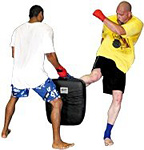 While there are several mixed martial arts icons, perhaps the most insightful is Pat Miletich. Pat is a five-time world champion who is very thoughtful and honest about the sport. He now operates one of the most successful MMA facilities in the country, developing many of the current and future world champions. In this exclusive interview, Pat Miletich pulls no punches as he discusses the realities of this exciting, often misunderstood sport.
While there are several mixed martial arts icons, perhaps the most insightful is Pat Miletich. Pat is a five-time world champion who is very thoughtful and honest about the sport. He now operates one of the most successful MMA facilities in the country, developing many of the current and future world champions. In this exclusive interview, Pat Miletich pulls no punches as he discusses the realities of this exciting, often misunderstood sport. What is mixed martial arts?
 For the layman, mixed martial arts is basically a combination of boxing, kickboxing, wrestling and submission grappling. Submission grappling is the art of getting joint locks on the elbows, shoulders, knees and ankles that would potentially sublux or dislocate the joints, and also chokeholds, which cut off the blood to the brain. It's all the Olympic sports combined into one. It's the closest thing to real combatives that you can ever have.
For the layman, mixed martial arts is basically a combination of boxing, kickboxing, wrestling and submission grappling. Submission grappling is the art of getting joint locks on the elbows, shoulders, knees and ankles that would potentially sublux or dislocate the joints, and also chokeholds, which cut off the blood to the brain. It's all the Olympic sports combined into one. It's the closest thing to real combatives that you can ever have. You've been at this for quite awhile. How did you get involved?
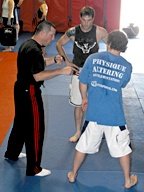 I stumbled into the sport. I was in college wrestling and my mother became ill with heart problems. I left school to help take care of her. I worked three jobs at the time. I was invited to come up to a gym that did kickboxing and martial arts, and found that I had a knack for it.
I stumbled into the sport. I was in college wrestling and my mother became ill with heart problems. I left school to help take care of her. I worked three jobs at the time. I was invited to come up to a gym that did kickboxing and martial arts, and found that I had a knack for it. I started fighting to make extra money to help pay my mother's bills. It just kind of snowballed from there. I held the world title for four years. I was the United States kickboxing champion before that. It's been a unique journey. Everything happens for a reason. Back then, I was mad that I couldn't finish college, but now that I'm where I'm at today, I've had a great life. I've been very blessed - five-time world champion. We've trained 11 world championship fighters as well as fighters for 70 pay-per-view fights in about six years. How does someone become a world-class fighter? What's the process?
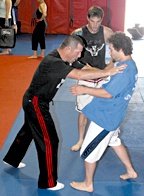 Now that the sport has grown so much, a lot of people show up here at the gym and say, "I want to be in the UFC (Ultimate Fighting Championship)." We say, "Great. Here's a class schedule." You need to go to basic classes for about a year or two. Once you become one of the best in the basic class, come over to the advanced class and we'll see how you do there. After you've been there for a year or two, then we might get you in an amateur fight if you're still around. If you do well in the amateur ranks, you can fight pro fights, and if you win a lot of pro fights, you might get into the UFC.
Now that the sport has grown so much, a lot of people show up here at the gym and say, "I want to be in the UFC (Ultimate Fighting Championship)." We say, "Great. Here's a class schedule." You need to go to basic classes for about a year or two. Once you become one of the best in the basic class, come over to the advanced class and we'll see how you do there. After you've been there for a year or two, then we might get you in an amateur fight if you're still around. If you do well in the amateur ranks, you can fight pro fights, and if you win a lot of pro fights, you might get into the UFC. Fighting requires a lot of dedication and eating right, an understanding of diet and sleep, and an understanding that you have to be able to do functional fitness, weight lifting, swimming, and different types of aerobics and anaerobics. Consider how long it takes to become a good boxer and multiply that by four, because you've got to be a good boxer, kickboxer and wrestler. Wrestling is a very intricate art, and you've also got to be good at submission grappling, which involves infinite amounts of combinations of submissions, pathways to get from one position to another position to a submission, and then knowing how to counter their escapes. What kind of training do you do? Each day will vary. For instance, on a Monday, someone would come in and do functional fitness, plyos, a lot of off-the-ground training with weight vests, different types of pull-ups, rope climbing, weight lifting and running, whether it's track sprints, timed miles, 440s, 220s, ten 100 yard dashes, or carrying a guy on your shoulders or on your back up a stadium 5-6 times in a row. That would be a type of endurance workout. Then you've got to do your technique training, whether it is learning submissions, submission escapes, positioning on the ground or how to get from one position to another. There's a lot of that to learn. Then they go home, have lunch and sleep, because they won't be able to come back and train hard in the evening if they don't rest their body.
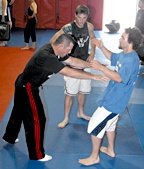 Tonight, the fighters will be training 12 three-minute rounds with 30 second rests in between. It's all stand-up fighting to focus on that portion of their game. Then, at the end, we'll probably go over to a hill that takes 1 1/2 minutes to get up and they'll have to do that 10-12 times in a row, and that'll be the end of the training session.
Tonight, the fighters will be training 12 three-minute rounds with 30 second rests in between. It's all stand-up fighting to focus on that portion of their game. Then, at the end, we'll probably go over to a hill that takes 1 1/2 minutes to get up and they'll have to do that 10-12 times in a row, and that'll be the end of the training session. What kind of nutritional regimen do the fighters follow? Diet and supplementation are important. A lot of fighters have their own way of doing things, but it's generally the same as far as diet. For breakfast, somebody my size should be eating eight egg whites with spinach, and maybe some oatmeal with a little honey. I have to jump-start my metabolism every day and make sure it's churning right away to help burn fat. Most fighters have a meal or a protein shake a couple hours later and then lunch, which would be a lean meat like chicken or fish, greens like broccoli, asparagus or spinach, and brown rice. We're always looking at rehydrating with a lot of fluids - at least 1-2 gallons of water per day.
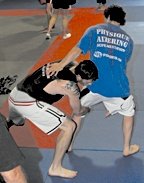 They'll have another protein shake a couple hours later. For some fighters, dinner is after training. Some will eat a small dinner before training and then after training, they'll eat again. Usually, it comes down to putting about 5-6 meals per day in your body.
They'll have another protein shake a couple hours later. For some fighters, dinner is after training. Some will eat a small dinner before training and then after training, they'll eat again. Usually, it comes down to putting about 5-6 meals per day in your body. Supplementation includes mostly whey protein, glutamines and those types of supplements. For over a decade, our team has used one supplement that everybody that's won a world title out of this gym has used - an antioxidant formula used by some of the best marathon runners and triathletes in the world that I luckily got my hands on years ago. It's an incredible supplement. It allows your muscles to soak up about 25-30 percent more oxygen at a cellular level. Once my muscles run out of oxygen, they use sugar for energy, producing lactic acid. If my muscles don't have to revert to burning sugar for energy, they don't get tired and I can keep going every day harder and harder. And I don't need to recover like most people do. The antioxidants are very important. Is there any additional health care your fighters need while they're training?
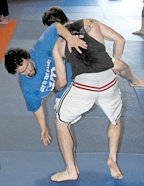 Probably 90-95 percent of professional fighters out there use chiropractic to maintain their bodies. It takes them awhile to understand you don't go to see the chiropractor for injuries; you go to maintain your body so you don't end up having injuries as often. Things that are about to happen to you don't because they're corrected before they can show themselves or manifest with pain.
Probably 90-95 percent of professional fighters out there use chiropractic to maintain their bodies. It takes them awhile to understand you don't go to see the chiropractor for injuries; you go to maintain your body so you don't end up having injuries as often. Things that are about to happen to you don't because they're corrected before they can show themselves or manifest with pain. Can you give us an example of a situation in which you were injured and chiropractic played a role in your healing? I could give examples all day. To give one example, I was training for my first fight in the UFC, my big shot, and I was up against the wrestling mats on the wall. We use the wall like a cage, and one of my training partners was trying to take me down. I had one leg out straight and the other one underneath me, and two 250 pound guys fell on my leg and buckled my knee the wrong way, doing a lot of damage to the ligaments. I couldn't bend my leg for two months. I went to an orthopedic surgeon who said it was just scar tissue and swelling that would eventually subside. The same day, I went to see a chiropractor who specialized in sports medicine. He felt the back of my knee and said my tibia was halfway out of socket. I had been walking around and even jogging for two months in that condition. So, he adjusted it and instantly, I could bend my leg again. It healed up rapidly after that. I was able to compete in the first UFC two months later. Chiropractic saved me there. One of my most severe injuries was to my neck when I was training for a world title fight. One of my training partners, when we were warming up, threw a hard left hook and I felt my neck crunch. I finished sparring and after two weeks, the left side of my body continually got worse and worse. My muscles were atrophying and I couldn't lift my arm. I went to see a neurosurgeon, who did an MRI on me. My spinal cord had been crushed by my disc between C5 and C6 and was almost severed. I got very lucky. He told me I had to have surgery to fuse my discs. I didn't like what he had to say, so I saw two more neurosurgeons, who said the same thing: "You're useless unless you get the surgery." I sent my MRI to my cousin, who was the head of neurology at Johns Hopkins, and he agreed that I needed surgery.
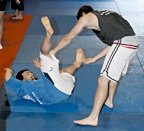 So, I went to see some chiropractors. I did traction, chiropractic care, rehab and strength training. My neck's not 100 percent, but after about a year of rehab, I was able to spar with my world champion fighters, wrestle with them and go 100 percent. My disc has receded almost completely off the spinal cord, so it's proven that chiropractic can take care of you after a severe injury.
So, I went to see some chiropractors. I did traction, chiropractic care, rehab and strength training. My neck's not 100 percent, but after about a year of rehab, I was able to spar with my world champion fighters, wrestle with them and go 100 percent. My disc has receded almost completely off the spinal cord, so it's proven that chiropractic can take care of you after a severe injury. Do you have any recommendations for people who just want to stay healthy and fit? The four most important things are: - diet, including supplementation;
- rest;
- training with good people; and
- chiropractic care to maintain the body.
The way I explain it to people who don't understand chiropractic is: If you're walking down the street and you have a rock in your shoe, and it hurts really bad, do you walk to the store to buy some Tylenol or Motrin and keep walking with the rock in your shoe, or do you stop and pull the rock out of your shoe? There's a disconnect in American society - people get muscle relaxers or painkillers to mask the symptoms of pain but they never address the problem, instead of going to a chiropractor and taking care of the source of the problem and maintaining the body correctly. That's really important. Chiropractic has saved my career numerous times, and that's what I advise my fighters to do. Who is Pat Miletich? Pat Militech is a guy who, for whatever reason, whether God saw it as the best path or whatever, has ended up winning a world title and somehow leaned toward helping other kids win world titles and direct people in their lives a bit. I try to serve as a bit of a role model for people. I see my young self a lot in my fighters, so I try to give them as much direction as I can.
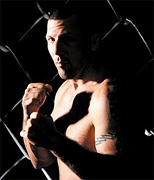 Pat “The Croation Sensation” Miletich
I was lucky to have great coaches when I was growing up in high school and college - guys that replaced my father. If it wasn't for them, I know I wouldn't have ended up where I am today. So I thank those guys for being in my life. That's really it. I'm just a guy trying to do his best in life to help other people. One thing I've learned through all of this is the more you serve other people in whatever it is you do, the more it ends up coming back to you. The more people that care about you, the better off you are in life. It's important to have a lot of friends and not many enemies.
Pat “The Croation Sensation” Miletich
I was lucky to have great coaches when I was growing up in high school and college - guys that replaced my father. If it wasn't for them, I know I wouldn't have ended up where I am today. So I thank those guys for being in my life. That's really it. I'm just a guy trying to do his best in life to help other people. One thing I've learned through all of this is the more you serve other people in whatever it is you do, the more it ends up coming back to you. The more people that care about you, the better off you are in life. It's important to have a lot of friends and not many enemies. Is there anything else you want to add? For anybody out there who hasn't seen the sport, or maybe hasn't educated themselves on the sport, please try and go to a gym where they actually teach it, understand the intricacies of it and how complex it is, and what it takes to actually be good at this sport. Don't judge it until you fully understand it. Over the years, there have been a lot of critics of our sport. Once they realized what it was really about, they fell in love with it. If you give it a chance, you'll understand why it's growing so fast.
Page printed from:
http://www.toyourhealth.com/mpacms/tyh/article.php?id=945&no_paginate=true&no_b=true
| 
